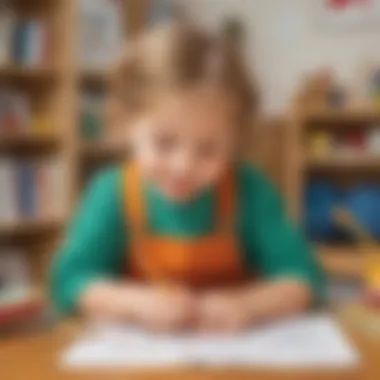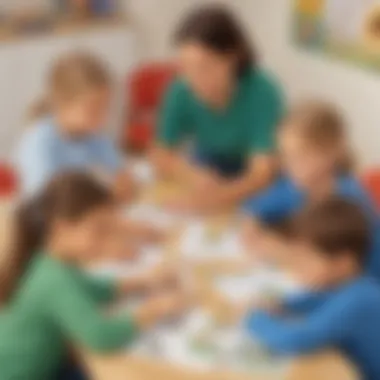Essential Kindergarten Skills: A Comprehensive Guide for Parents and Educators


Interactive Learing Games
Children's kindergarten years are a crucial time when foundational skills are developed. Interactive learning games play a significant role in engaging young learners and fostering their cognitive abilities. Some widely popular games include 'Coddorgan' and 'WorldBuild,' which are designed to stimulate critical thinking and problem-solving skills.
These games offer an immersive learning experience, encouraging children to explore new concepts and ideas in a fun and interactive manner. The benefits of playing educational games for kids' cognitive development cannot be overstated; they help improve memory retention, enhance decision-making skills, and promote creativity in problem-solving scenarios.
In addition to popular games, this section provides in-depth game reviews, highlighting the gameplay mechanics, learning outcomes, and user experiences. By comparing different games, parents and educators can make informed decisions on which games best suit their child's learning objectives.
Educational Topics
As part of the comprehensive Kindergarten Skill Checklist, it is essential to cover a wide range of educational topics that are crucial for a child's holistic development. This section offers a compilation of articles spanning various subjects such as math, science, languages, and more.
Interdisciplinary learning is emphasized to provide a well-rounded educational experience, helping children make connections between different subjects and fostering a deeper understanding of the world around them.
Tips and Tricks
Empowering parents and educators with practical tips is key to enhancing children's learning journey. This section provides strategies for making learning both fun and engaging, ensuring that young learners stay motivated and enthusiastic about acquiring new knowledge.
Creative teaching methods and innovative approaches are explored to cater to the diverse learning styles of children. By incorporating these tips into daily learning routines, parents and educators can create enriching experiences for children that support their cognitive and emotional growth.
Creative DIY Projects
Encouraging creativity and hands-on learning, this section features step-by-step guides for engaging DIY projects that promote artistic expression and critical thinking. Children benefit immensely from hands-on activities, as they facilitate the development of cognitive and motor skills.
Craft ideas using simple household items are shared, emphasizing the importance of artistic expression in nurturing children's creativity. By engaging in creative DIY projects, children can explore their imagination, develop problem-solving skills, and unleash their artistic potential.
Introduction
Understanding Kindergarten Skills
In this section, we delve into the foundational aspects of kindergarten skills, shedding light on the significance of early childhood development and offering a detailed overview of the kindergarten curriculum.


The Importance of Early Childhood Development
Early childhood development plays a pivotal role in shaping a child's overall growth and future success. Emphasizing the importance of nurturing skills during the formative years, this section highlights the critical role early experiences play in shaping cognitive, social, emotional, and physical abilities. Understanding the essence of early childhood development is key to laying a strong foundation for a child's ongoing learning journey. By exploring the unique features of early childhood development and its advantages within the context of this article, readers gain valuable insights into why focusing on this aspect is imperative for fostering comprehensive development in young learners.
Overview of Kindergarten Curriculum
A comprehensive understanding of the kindergarten curriculum is essential for both parents and educators to facilitate effective learning experiences. This section delves into the key components of the curriculum, outlining its pivotal role in promoting cognitive growth, social interactions, and emotional well-being among kindergarten children. By highlighting the distinct features of the kindergarten curriculum and discussing its advantages and potential shortcomings within the scope of this article, readers gain a deeper appreciation for how the curriculum shapes the educational journey of young learners.
Cognitive Skills
In this ever-evolving landscape of early childhood development, cognitive skills stand as the cornerstone of a child's intellectual growth. Nurturing cognitive abilities from an early age sets the stage for lifelong learning and problem-solving. Within the realm of cognitive development, the acquisition of language and literacy skills plays a pivotal role. Understanding the crucial role of cognitive skills in shaping a child's academic journey is essential for both parents and educators. By focusing on cognitive skills like language and literacy, children can enhance their communication, comprehension, and critical thinking abilities, laying a robust foundation for future academic success.
Language and Literacy
Recognizing Letters and Sounds
A fundamental aspect of language and literacy development in kindergarteners is the recognition of letters and sounds. This skill forms the bedrock of literacy acquisition, enabling children to decode written language and understand the phonetic composition of words. Recognizing letters and sounds not only fosters reading proficiency but also enhances a child's ability to communicate effectively. The systematic approach to teaching this skill enhances children's vocabulary, reading fluency, and overall linguistic competence, culminating in improved literacy outcomes. Despite its initial complexities, mastering the recognition of letters and sounds equips children with the foundational skills necessary for successful language acquisition.
Emergent Reading Skills
Emergent reading skills encompass the early stages of reading development, where children begin to explore written language independently. This phase marks a critical juncture in a child's literacy journey, as they transition from decoding individual words to grasping the meaning of complete sentences and passages. Cultivating emergent reading skills instills a sense of curiosity and engagement with written material, fostering a lifelong love for reading. By encouraging children to explore various genres and texts, educators can nurture their comprehension skills and promote literary exploration. Embracing emergent reading skills empowers children to broaden their literary horizons and engage with diverse narratives, enriching their cognitive development.
Developing Vocabulary
The development of vocabulary plays a pivotal role in enhancing a child's language proficiency and communication skills. A rich and varied vocabulary enables children to articulate their thoughts effectively, express emotions, and engage in meaningful interactions. By exposing children to a wide array of words through storytelling, conversation, and educational activities, educators can broaden their lexical repertoire. Developing vocabulary not only enhances linguistic capabilities but also cultivates a nuanced understanding of language nuances and subtleties. Encouraging the active use and exploration of vocabulary empowers children to communicate confidently and articulate their ideas with clarity and precision, fostering language development and cognitive growth.
Mathematics
In the realm of early childhood education, mathematical skills form a crucial component of a child's cognitive development. Mathematics paves the way for logical reasoning, problem-solving, and quantitative literacy, equipping children with essential tools for academic success. Exploring mathematical concepts such as number recognition, counting skills, and basic addition and subtraction lays a robust foundation for developing numerical fluency and spatial awareness. By cultivating mathematical skills early on, children can enhance their analytical thinking, numerical proficiency, and problem-solving abilities, fostering a holistic approach to cognitive development.
Number Recognition


Number recognition serves as a fundamental building block in a child's mathematical journey, enabling them to identify, differentiate, and manipulate numerical symbols. This skill not only cultivates basic numeracy but also establishes a strong foundation for advanced mathematical concepts. Through interactive and hands-on activities, children can develop proficiency in recognizing numbers, fostering a deep understanding of numerical relationships and sequences. By integrating number recognition into daily learning experiences, educators can promote mathematical fluency and enhance children's ability to engage with mathematical concepts confidently.
Counting Skills
Counting skills play a pivotal role in developing a child's quantitative understanding and numerical fluency. From simple rote counting to more complex sequential counting, this skill empowers children to quantify objects, sequences, and quantities accurately. Counting skills lay the groundwork for mathematical operations, spatial reasoning, and pattern recognition, fostering a conceptual understanding of numbers. By incorporating counting activities into everyday routines and educational tasks, educators can enhance children's numeracy skills and promote a deeper appreciation for mathematical concepts. Encouraging hands-on exploration and tactile engagement can enrich children's counting skills, leading to confident and proficient mathematical abilities.
Basic Addition and Subtraction
The mastery of basic addition and subtraction is a key milestone in a child's mathematical development, enabling them to perform arithmetic operations with confidence and accuracy. By cultivating an understanding of addition as combining and subtraction as separating, children can grasp fundamental mathematical concepts early on. Basic addition and subtraction skills lay the groundwork for more complex mathematical operations and problem-solving strategies, fostering a solid mathematical foundation. Through interactive games, manipulatives, and real-world applications, educators can engage children in exploring addition and subtraction, promoting conceptual understanding and numerical dexterity. Embracing basic addition and subtraction empowers children to tackle mathematical challenges with resilience and precision, enhancing their overall mathematical proficiency.
Social and Emotional Skills
In this section of the comprehensive guide on Kindergarten Skill Checklist, we delve into the pivotal realm of Social and Emotional Skills. Recognizing the significance of fostering these skills in young learners is paramount for their overall development. It goes beyond academic achievements, emphasizing the intrinsic values of empathy, communication, and relationship-building.
Social Interaction
Exploring the dynamics of Social Interaction unveils a fundamental pillar in a child's growth journey. Developing Friendships emerges as a key element within Social Interaction, embodying the essence of genuine connections and companionship. Nurturing the ability to form meaningful relationships during the formative years not only enhances social competence but also fosters emotional resilience and mutual understanding.
Delving deeper into Developing Friendships, we encounter its role in shaping a child's social landscape. The capacity to forge friendships instills essential social skills such as cooperation, empathy, and conflict resolution. The core characteristic of Developing Friendships lies in promoting a sense of belonging and emotional security among peers, creating a conducive environment for social growth.
In the realm of Sharing and Taking Turns, we unravel another vital facet of Social Interaction. This practice instills the values of teamwork, patience, and consideration for others. Encouraging children to share and take turns not only cultivates interpersonal skills but also nurtures a sense of fairness and inclusivity.
Highlighting the unique feature of Sharing and Taking Turns within the context of this article underscores its pivotal role in fostering social harmony and cooperative learning. By promoting equitable engagement and fostering respect for each other's perspectives, this aspect enriches the social fabric of the classroom and beyond.
Embracing Social Interaction as a cornerstone of early childhood development equips young learners with the essential tools for navigating social complexities and building meaningful relationships. By emphasizing the importance of Developing Friendships and Sharing and Taking Turns, this guide champions the holistic growth of children, laying a strong foundation for their future endeavors.
Physical Development
Physical development plays a crucial role in the holistic growth of young children. This section of the Kindergarten Skill Checklist delves into the significance of fostering physical abilities in early learners. By focusing on gross motor skills like running and jumping, balance, and coordination, parents and educators can enhance children's physical prowess and overall well-being.
Gross Motor Skills


Gross motor skills encompass fundamental movements that involve large muscle groups. Within this category, two key aspects are highlighted: running and jumping, and balance and coordination.
Running and Jumping
Running and jumping are essential activities that promote cardiovascular health, muscle strength, and coordination in children. These dynamic movements aid in the development of physical fitness and agility. The act of running and jumping also fosters a sense of exploration and risk-taking, essential for healthy physical development. Additionally, these activities enhance spatial awareness and encourage sensory-motor integration. While running and jumping are exhilarating for children, they also teach valuable lessons in perseverance and overcoming challenges.
Balance and Coordination
Achieving balance and coordination is foundational for physical prowess. These skills enable children to navigate their surroundings with confidence and grace. Developing balance and coordination enhances posture, stability, and overall body control. Moreover, mastering these skills contributes to the refinement of fine motor abilities, setting the stage for more intricate tasks in the future. By engaging in activities that challenge balance and coordination, such as balancing on one leg or navigating obstacle courses, children hone their motor skills and spatial awareness.
Creativity and Problem-Solving
Creativity and problem-solving skills play a vital role in a child's holistic development, making them essential components of the Kindergarten Skill Checklist. Encouraging creativity from a young age fosters innovative thinking, imagination, and resourcefulness. It allows children to explore multiple solutions to a single problem, promoting critical thinking and unique perspectives. Problem-solving skills, on the other hand, equip children with the ability to analyze situations, identify challenges, and devise effective solutions. By integrating creativity and problem-solving into the educational framework, children enhance their adaptability, resilience, and confidence when facing diverse challenges.
Artistic Expression
Drawing and Painting
Drawing and painting serve as foundational components of artistic expression, allowing children to communicate thoughts, emotions, and experiences visually. The act of drawing enhances fine motor skills, hand-eye coordination, and attention to detail. Through painting, children experiment with colors, textures, and techniques, stimulating creativity and sensory exploration. The process of creating visual art promotes self-expression, boosts confidence, and nurtures an appreciation for aesthetics. While drawing and painting contribute significantly to a child's cognitive and emotional development, drawing enables children to convey intricate details, thoughts, and stories through visual representation.
Creative Play
Creative play encourages children to engage in activities that ignite imagination, problem-solving, and social interaction. By immersing children in imaginative scenarios, creative play cultivates cognitive flexibility, emotional intelligence, and collaborative skills. The open-ended nature of creative play empowers children to construct narratives, invent solutions, and explore limitless possibilities. This form of play fosters spontaneity, adaptability, and decision-making abilities in children. Through creative play, children learn to navigate uncertainties, resolve conflicts, and express themselves authentically within a structured yet imaginative context.
Conclusion
The conclusion section of this article acts as the culminating point, drawing together the intricacies and significance of the Kindergarten Skill Checklist. It serves as a pivotal aspect in guiding parents, educators, and caregivers in understanding the holistic development required during the formative kindergarten years. Delving into the multifaceted cognitive, social, emotional, and physical aspects, the Conclusion encapsulates the essence of fostering a well-rounded growth environment for young learners. By emphasizing the importance of supporting children through various dimensions, this section aims to illuminate the pathway towards nurturing essential skills pivotal for future success. Overall, the Conclusion acts as a beacon, illuminating the inherent value of the Kindergarten Skill Checklist and highlighting its indispensable role in shaping the educational journey of children.
Supporting Your Child's Growth
Encouraging Learning at Home
When it comes to encouraging learning at home, the specific aspect entails creating a conducive environment that fosters continuous intellectual stimuli and growth opportunities outside the traditional classroom setting. This approach plays a pivotal role in complementing formal education efforts by engaging children in meaningful activities that enhance their cognitive abilities and knowledge retention. The key characteristic of encouraging learning at home lies in its ability to reinforce learning acquired at school, thereby deepening understanding and mastery of academic concepts. It serves as a beneficial choice for this article, given its proven efficacy in enhancing educational outcomes and promoting a seamless transition between school and home learning environments. The unique feature of encouraging learning at home is its personalized nature, allowing tailored educational experiences that cater to the specific needs and pace of individual children. This adaptability brings forth advantages such as increased engagement, retention, and growth in a familiar and comfortable setting, fostering a love for learning early in a child's developmental journey.
Communicating with Teachers
Communication with teachers plays a pivotal role in nurturing a collaborative and supportive educational ecosystem for children. This specific aspect involves establishing open channels of communication between parents, educators, and caregivers to ensure a holistic approach to a child's academic and personal development. The key characteristic of communicating with teachers is its power to create a cohesive support system that aligns classroom experiences with home dynamics, fostering consistency in guiding children towards their educational goals. It is a popular choice for this article due to its instrumental role in enabling stakeholders to work together seamlessly, sharing insights, challenges, and wins to enhance the overall learning experience for children. The unique feature of communicating with teachers lies in its ability to promote transparency, mutual understanding, and partnership among all parties involved in a child's educational journey. This fosters advantages such as personalized support, early intervention, and tailored strategies that cater to the unique needs of every child, emphasizing a collaborative approach towards nurturing a well-rounded and thriving educational environment.















